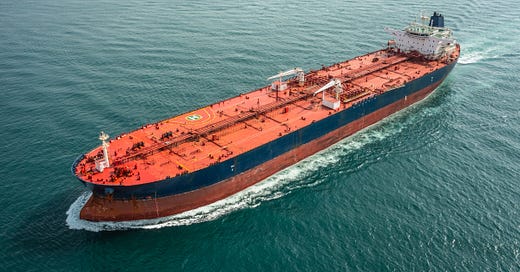Shipping investing is a lucrative yet challenging endeavor. Multiple shipping companies of all sizes operate various types of ships. Big names like Frontline, Scorpio Tankers, and StarBulk are popular among generalists. However, the shipping universe has more to offer for adventurous investors.
Shipping nanocaps are probably the most esoteric part of the industry. They operate in all shipping segments: tankers, bulk carriers, LNG carriers, car carriers, and containers. Preferred units with attractive dividends, massive discounts to NAV, and questionable management are standard qualities for any nanocap shipowner.
In a series of two articles, I dig into tanker nanocaps. Today’s write-up covers crude and product tanker fundamentals. In the following chapter, you will read about two tanker nanocaps.
The tanker segment is not homogenous. Depending on the type of cargo, tankers carry crude oil or clean petrol products. Moreover, they vary in size, from ULCC, which can transport three million barrels, to Handysize, which has a 300,000-barrel capacity.
Investing in shipping stocks requires knowledge of the industry. Being familiar with tanker sizes is a prerequisite. Tankers come in standard sizes, illustrated in the following chart:
Various tankers have distinct fundamentals: order book and fleet age. Let’s dig into the tanker market dynamics.
Tanker market fundamentals
Considering the growing tonne-mile demand and robust fundamentals, the VLCCs bring the best risk-reward among the tankers.
The VLCC supply side remains constrained by a low order book of 4.6% and limited shipyard capacity due to significant orders for another ship (LPG, LNG, containers). Charts via Frontline plc.
This means shipowners have to wait at least 18 months for a new VLCC. Two deliveries are expected in 2024, while five in 2025. 2026 is supposed to be the decisive year, with 11 new builds to be delivered. However, the global VLCC fleet is aging progressively, so fleet growth is nonexistent.
Another factor is the aging fleet. By the end of 2026, about 50% of the global VLCC fleet is expected to be older than 15 years and 20% older than 20 years.
VLCCs involved in banned trades, 160 vessels, put more pressure on the supply side.
This is 18% of the global fleet of 887 VLCCs. With more sanctions on Russian entities and, most importantly, on Sovcomflot, the supply side for crude tankers will remain constrained.
Suezmax and Aframax are the next in size crude oil tankers. The charts below represent projected Aframax/Suezmax fleet growth for the next 36 months. Charts via Banchero Costa.
The growth rate remains in the low single-digits region for both types of vessels. The Aframax fleet is aging fast, given that 17% of the fleet is above 20Y. LR2 vessels older than 20Y represent 5% of the global LR2 fleet. Hence, 12% of the LR2/Aframax fleet is older than 20Y. In conclusion, the supply side of LR2/Aframax ships remains limited due to an aging fleet and relatively low order book, unable to offset the rising fleet age.
The following TORM plc 2023 annual report chart shows product tankers' order book and expected deliveries.
Clean tanker order book for 2024-2026 is 9%. LR2 tankers have the highest order book, 24%. However, LR2 vessels could carry crude oil, too. So, we have to consider the Aframax order book. The combined LR2/Aframax order book is around 13%.
Considering fleet age and order book, MR tankers are among the most attractive in the class. Chart via Ardmore Shipping.
In 2023, the average age of the MR fleet was 13.1 years, while the order book was about 8%. 47% of the fleet is older than 20, so those ships must be replaced in the coming years. MR's order book reached record low levels for the last 28 years.
Due to growing refinery dislocation, product tankers' tonne-mile demand is poised to grow. The map below via Ardmore 1Q24 presentation shows the present stage of large crude oil refineries.
The geographical dislocation between supply and demand also increases tonne-mile demand for crude oil tankers. Supply is projected to grow at a higher rate West of Suez, while demand is expected to increase faster East of Suez. The chart below from the last Okeanis Eco Tankers presentation illustrates that.
India and China are the prime drivers in the East. India consumes around 5 million barrels daily, or 5% of global daily demand. According to IEA projections, India’s demand will reach 6.6 million barrels daily in 2030.
Not all tankers are equal. At that stage of the shipping cycle, VLCCs and MRs suggest the best risk-reward profile, considering market fundamentals. So, companies that own MRs and VLCCs are top priority. Two enterprises come to mind from the nanocap universe:
· Imperial Petroleum, IMPP
· TOP Ships, TOPS
The companies do not fall strictly into the VLCC/MR-only category. IMPP and TOPS own tankers of other sizes, too. Nevertheless, VLCC/MR tankers generate at least half of the companies’ revenue. Part 2 article discusses IMPP and TOPS and the pros and cons of nanocaps investing. Stay tuned.















Both shitco's are well known by never-ending legendary dilution and destruction of shareholders' value.
Mihail,let me see if I got it. The Tanker tesis is similar to Dry bulk one: aging fleet, low shipyard capacity, and low order book. Right? One doubt: the tanker tesis is dependent on Brent prices like Drillers and Oil stocks? Thanks!